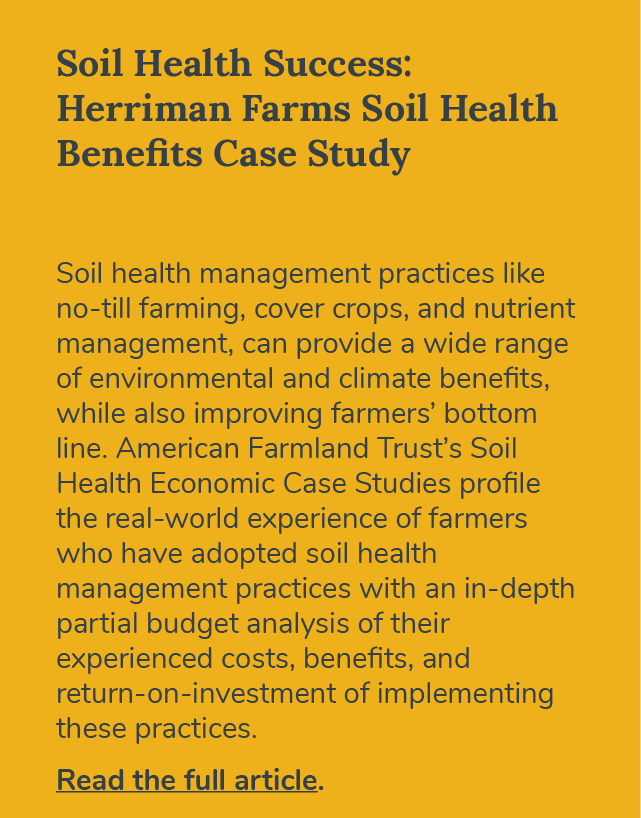In recent years, the United States government has significantly increased its support for the implementation of Natural Climate Solutions (NCS) on American natural and working lands. This surge in funding has paved the way for a diverse array of programs aimed at expanding the adoption of these innovative strategies across the nation. NCS encompasses land management approaches designed to harness the power of forests, farms, grasslands, coastal and marine ecosystems, and urban environments to either reduce greenhouse gas emissions or capture and store carbon dioxide from the atmosphere.
During New York Climate Week 2023, the U.S. Nature4Climate coalition organized an expert panel to delve into the U.S. government’s role in promoting NCS implementation. The panel featured prominent figures in the field, including:
- Britt Groosman, Vice President of Climate Smart Agriculture at the Environmental Defense Fund
- Heather Tallis, Assistant Director for Biodiversity and Conservation Sciences at the White House Office of Science and Technology Policy
- Sean Babington, Senior Advisor at the United States Department of Agriculture
- Freddie Davis, Director of the Rural Training and Research Center at the Federation of Southern Cooperatives
- Emily Luscombe, Natural Resources Director at the Intertribal Agriculture Council.
The discussion was expertly moderated by Daniel Bresette, President of the Environmental and Energy Study Institute (EESI), and introduced by Sacha Spector, the Environment Program Director at Doris Duke Foundation, who emphasized the unprecedented opportunity in the U.S. with various federal funding sources for Natural Climate Solutions and expressed excitement about the potential of these solutions for climate mitigation and adaptation.
The Big Picture
Britt Groosman, Vice President of Climate Smart Agriculture at the Environmental Defense Fund, initiated the discussion by highlighting the pressing issue of climate change in relation to agriculture. She emphasized that globally, agriculture contributes one-quarter of greenhouse gas emissions, especially when considering deforestation driven by agricultural activities. She added that climate-induced challenges like droughts and heatwaves are making farming increasingly risky and costly.
Groosman underscored the urgency of addressing this issue by stressing the importance of carbon dioxide removal, not just emission reduction. She pointed out that nature, with its intrinsic carbon-capturing capabilities, plays a crucial role in this endeavor.

Groosman cited a study conducted by the Environmental Defense Fund that outlined the pathways to a stable climate for agriculture in the U.S., which included the need to cut methane emissions in agriculture by 25%, reduce nitrous oxide emissions by 9%, curtail carbon emissions resulting from land use changes by 72%, and increase carbon storage in forests by 32%. It was emphasized that preventing the conversion of land for agricultural use is crucial since future emissions from the agricultural sector will primarily arise from land conversion.
Groosman identified the Farm Bill as a significant opportunity for funding NCS implementation, featuring key programs such as the Conservation Stewardship Program, the Environmental Quality Incentives Program (EQIP), the Agriculture Conservation Partnership Program (ACEP), and the Regional Conservation Partnership Program (RCPP), all of which lack resources to meet high demand, despite a significant infusion of funding for many of these programs from the Inflation Reduction Act (IRA), which dedicated $20 billion for conservation agriculture programs and added climate change mitigation criteria to qualify for funding.

Groosman concluded by stating that the next step is for the environmental community to collaborate with the agriculture sector to build a better foundation for climate action, including expanding technical assistance and climate services capacity, technology deployment to track changes in emissions, research into how climate-focused farming can increase resilience and yield, and more farmer-focused education.
[Explore EESI’s 2023 Farm Bill Briefings to learn more.]
Driving Action: Mechanisms for Supporting Implementation
The White House Office of Science & Technology Policy‘s Heather Tallis then reiterated the untapped potential of NCS in addressing climate change and detailed how the federal government has responded. She stressed that we are currently utilizing just a fraction of what nature offers to mitigate and adapt to climate change. Tallis referenced a recent study (Beck et. al, 2022) that demonstrates the cost-effectiveness of restoring coral reefs and mangroves for coastal risk reduction, highlighting the potential of NCS for adaptation.

In response to these opportunities, the federal government published a National Nature-based Solutions Roadmap, co-chaired by Tallis and colleagues at the White House’s Council on Environmental Quality and Domestic Climate Policy Office, aimed at unlocking the full potential of nature-based solutions. This comprehensive effort involved multiple federal agencies, including non-natural resource agencies, signifying a holistic strategy for driving action across the government. The roadmap offers top-line recommendations that span policy updates, funding expansion, altered federal asset management, workforce development, and advancements in science and innovation. These recommendations aim to address the barriers hindering federal agencies from rapidly accelerating the adoption of nature-based solutions.

Tallis noted that there has been significant progress over the year since publishing the National Nature-based Solutions Roadmap. For example, funding notices have been adjusted to explicitly encourage the proposal of nature-based solutions, underlining the growing recognition that investments in nature are a vital element in climate action.
Sean Babington, Senior Advisor at the Department of Agriculture, then reiterated the importance of the agriculture sector in achieving climate goals by 2030. The USDA has several tools at their disposal to assist in implementing the Natural Climate Solutions needed to make this transformation, including Farm Bill conservation programs, IRA funding, Partnerships for Climate-Smart Commodities, and private investment opportunities.

It’s important to note that almost all of these financial mechanisms to advance implementation of climate-smart agriculture and forestry in the U.S. are significantly oversubscribed. For example, Babington elaborated on the USDA’s Partnerships for Climate-Smart Commodities initiative, which received substantial interest from producers, NGOs, universities, and the private sector. The program aims to increase the adoption of climate-smart agricultural practices and climate-smart forestry practices, with robust measurement, monitoring, reporting, and verification procedures in place to track progress.
“Basically, the USDA asked producers, NGOs, land grants, universities, the private sector, and corporations to come together and tell the USDA how they would plan to use some of this funding to increase the adoption of climate-smart agriculture production practices and climate-smart forestry practices. It was a very open-ended request. They received over $20 billion in applications for the $3 billion opportunity,” explained Babington.
Similarly, the discussion also touched on USDA’s Urban and Community Forestry Program, which also received significant interest and demonstrated the enthusiasm for such initiatives. This program aims to plant and maintain trees in urban areas across the country that have tremendous potential to improve the lives of people in communities affected by a lack of tree cover. For the $1.5 billion available in grants, they received over $7 billion in applications. “If you hear that producers don’t want this money or we should rescind this and put it towards something else, remember these subscription numbers,” said Babington.
On-the-Ground Implementation
Freddie Davis, the Director of the Rural Training and Research Center at the Federation of Southern Cooperatives, followed the discussion by shedding light on how their organization is utilizing federal programs to promote NCS among underserved landowners. The Federation of Southern Cooperatives focuses on cooperative development, advocacy, and land retention, with a primary mission of preserving land among underserved landowners. Davis emphasized the importance of climate-smart commodities in promoting regenerative agriculture practices and leveraging partnerships to market NCS products. Key programs, such EQIP and CSP, play a pivotal role in introducing NCS practices to producers.
Davis highlighted how these programs are instrumental in building capacity within their communities. Historically, many producers lacked the capacity to shift away from practices that were detrimental to their land in the long term. However, the inclusion of underserved components in these programs has provided opportunities for producers to implement NCS practices and gain access to markets that recognize the value of their products.

The panel concluded with a presentation from the Intertribal Agriculture Council‘s Natural Resources Director, Emily Luscombe, focusing on how tribes and the council are utilizing federal funding to implement NCS while ensuring equity and advancing environmental justice. She discussed the unique challenges faced by tribal communities in the context of regenerative agriculture and climate change, underscoring the importance of incorporating indigenous perspectives in agriculture. The Natural Resources program at the Intertribal Agriculture Council concentrates on promoting regenerative agriculture by working on practice changes and advocating for broader systems thinking.
Luscombe elaborated on the deep-rooted Traditional Ecological Knowledge (TEK) held by tribes, emphasizing the importance of acknowledging and valuing this knowledge, which has been tested and refined over thousands of years. This knowledge forms the basis for regenerative agriculture and nature-based solutions for climate change (or natural climate solutions). Luscombe also pointed out the historic barriers that tribal communities have faced, from jurisdictional complexities and land ownership issues to discrimination and marginalized lands. However, she highlighted that recent improvements are occurring, including provisions in the Farm Bill that better cater to tribal needs, recognizing the value of TEK and supporting climate-smart agriculture.

She also mentioned various federal programs and funding sources that tribes leverage for climate-smart agricultural projects, noting how tribes combine different programs to create holistic ecosystem restoration initiatives. Finally, she discussed a proposed provision in the 2023 Farm Bill that aims to establish tribal seed networks for better adaptation to microclimates and climate change, reflecting the ongoing efforts to improve conditions for tribal agriculture and climate resilience.
In conclusion, the increased support from the U.S. government for NCS implementation reflects a growing recognition of the pivotal role nature can play in mitigating climate change. This collaborative effort involves government agencies, environmental organizations, farmers, and indigenous communities, each contributing to the greater goal of achieving climate equity and environmental justice. The momentum gained in recent years, fueled by a commitment to natural climate solutions, demonstrates a path forward that holds significant promise. These efforts promise a more regenerative and climate-resilient future, unlocking the full potential of our natural landscapes in service of a healthier planet for all.
Explore programs implementing Natural Climate Solutions with support from federal funding, including the Farm Bill
Our farmers, ranchers, and foresters want to be part of the solution to climate change, but they need financial support to do so. Our latest page showcases programs implementing Natural Climate Solutions with support from federal funding, including the Farm Bill.
Discover how these solutions are addressing climate change and helping restore wildlife habitat, improve water quality, increase the productivity of our farms, create jobs, and protect our communities from storms and floods. Explore the impact.





















